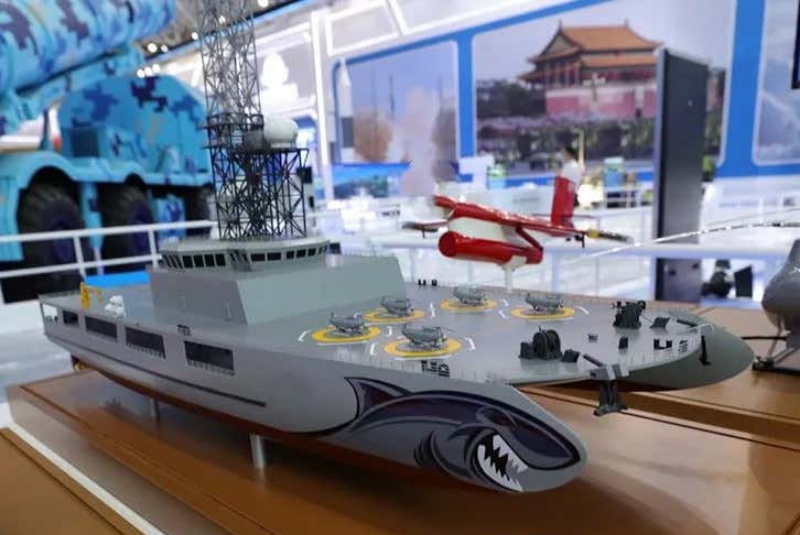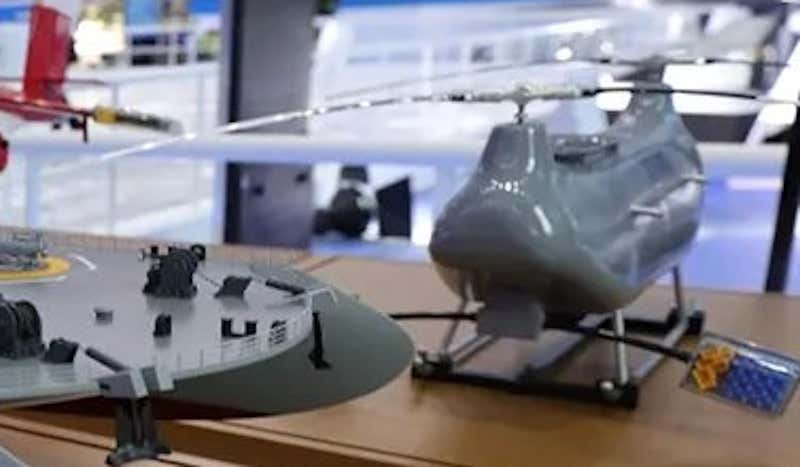China looks to have launched an odd mini-aircraft carrier of sorts that is intended to launch and recover small aerial drones earlier this year.
A model of this catamaran vessel appeared at this year’s Zhuhai Airshow, where it was ostensibly described as a platform for mimicking enemy “electronic” systems during training exercises.
This ship will be able to simulate hostile drone swarms, along with other kinds of threats, such as high-volume anti-ship missile strikes and distributed electronic warfare attacks. It also reflects the Chinese military’s interest in operational swarming capabilities, and especially in the maritime domain.
The photographs show a cartoon shark painted on the outer side of the ship’s twin hull. This made the ship very similar to the model displayed in Zhuhai. It is believed the state-run China Aerospace Science and Industry Corporation (CASIC) is involved in the development of the ship.
From the photographs, it is very evident how the ship is going to be employed in maritime exercises. For conducting a realistic drone swarm training exercise, it will be required to release a cluster of drones at once.
Another picture, seen below, from what would seem to be the same event shows a poster depicting the ship, along with the logo for the state-run China Aerospace Science and Industry Corporation, or CASIC. The model at Zhuhai was at a CASIC booth.
The model of the vessel at Zhuhai depicted it carrying five relatively small tandem-rotor drone helicopters on a large open foredeck in front of the main superstructure. In addition, it showed multiple large antenna domes, which might be associated with high-bandwidth communications systems that would be useful for controlling large groups of unmanned helicopters. The domes were mounting on a large tower on top of the superstructure that would offer a very good location just for positioning line-of-sight control links.
As for the drones themselves, the CASIC booth also had a separate model of one of them showing a bar underneath the fuselage with what appears to be some kind of radiofrequency signal emitter installed on either end. What could be other antennas are seen jutting out from the sides of the fuselage and the portly design points to some degree of internal payload capacity.
There was a small sign next to the model at Zhuhai with descriptions of the ship in Chinese and English. Available pictures of the sign do not provide a clear view of all of the English text, but part of it reads “Multifunctional Integrated Electronic Blue Army System.” In Chinese military parlance, mock opponents in training exercises are referred to as the “Blue Army.” This is in direct contrast to how the U.S. military and other western armed forces describe generic simulated enemies as the “Red Force.”
Based on this description, and from what we can see of the ship’s design and that of the drones on its deck, it’s not hard to imagine how it might be employed in maritime exercises both far out to sea and in littoral areas. For realistic training against swarms, it would be necessary to sortie lots of drones at once.
Beyond that, the unmanned helicopters could pump out signals reflecting the signatures of various kinds of missiles, or even just waves of manned or unmanned aircraft. The rotary-wing drones would be fitted with electronic warfare systems to carry out electronic attacks, as well. All of this would provide a relatively low-cost way to simulate swarms, along with other kinds of aerial threats during drills, and do so across a broad area.
The large open decks on the ship in front of and behind the superstructure might provide room for the addition of other capabilities. Catapults or static launchers for fixed-wing drones, including those designed specifically as targets, as well as recovery systems, could be installed in those spaces to expand the kinds of threats the vessel would be to simulate.
Source: The Drive
, China has built a kind of a “mini” aircraft carrier capable of launching and recovering UAVs. Images of this catamaran ship were also shared during the Zhuhai Air Show that concluded on October 3.
A catamaran is a vessel, which has twin hulls placed parallel to each other. The Chinese vessel was described as a platform capable of “mimicking” the enemy’s electronic systems during training drills.
The 80m-long and 35m wide ship will be capable of simulating hostile drone swarms and other threats such as high-volume anti-ship missile strikes and electronic warfare attacks. Photographs of the vessel started doing rounds on social media earlier this week. Reports suggest that this drone swarm mothership was launched sometime in May this year.
The photographs show a cartoon shark painted on the outer side of the ship’s twin hull. This made the ship very similar to the model displayed in Zhuhai. It is believed the state-run China Aerospace Science and Industry Corporation (CASIC) is involved in the development of the ship.
From the photographs, it is very evident how the ship is going to be employed in maritime exercises. For conducting a realistic drone swarm training exercise, it will be required to release a cluster of drones at once.





